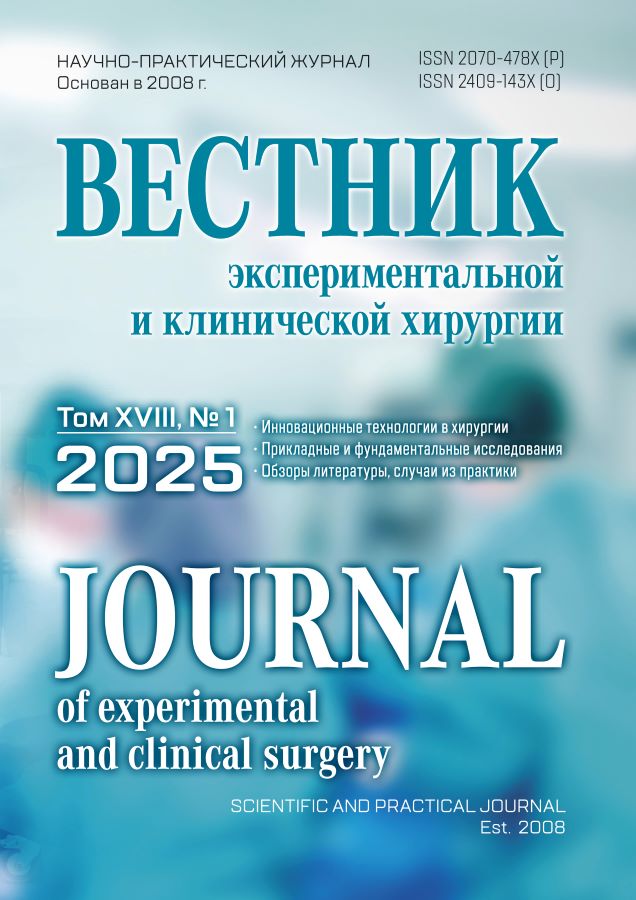Nanomedical technologies for bacterial infection prevention and novel perspectives in surgery
- Authors: Abdulagatov I.M.1, Ragimov R.M.2, Hamidov M.A.2, Abdullaeva N.M.2
-
Affiliations:
- Federal State Budgetary Educational Institution of Higher Education "Dagestan State Medical University" of the Ministry of Health of the Russian Federation
- Dagestan State Medical University
- Issue: Vol 18, No 1 (2025)
- Pages: 68-78
- Section: Review of literature
- URL: https://vestnik-surgery.com/journal/article/view/1820
- DOI: https://doi.org/10.18499/2070-478X-2025-18-1-68-78
- ID: 1820
Cite item
Abstract
This paper provides an overview of the current state-of-the-art for using nanotechnology achievements in medicine in Russia and abroad. The perspectives and challenges associated with the development and implementation of antibacterial nanocoatings in the industry of creating medical implants, instruments and medical devices are considered. Synthesis and technologies for deposition of antibacterial nanocoatings on the surface of medical implants and surgical products and materials are discussed. The results of preliminary research in the field of nanomedicine technologies and their various applications in surgery, as well as future perspectives, are presented. The authors support the effectiveness of using nanotechnology to impart antibacterial properties to implants in order to prevent postoperative complications, the fact ensuring improved quality, service life and reliability of the implants. Nanocoatings on the surface of medical implants and surgical materials allow providing their antibacterial and barrier properties, high strength, wear resistance, corrosion resistance, as well as the necessary favorable physical properties. As demonstrated, based on the analysed published Russian and foreign papers, the application of functional nanocoatings to implants and medical instruments allows solving numerous problems in medicine: in particular, it prevents penetration of toxic substances from implant materials into the body, biofilm formation on implants, infectious complications, since some nanofilms have antibacterial properties; it increases the service life and reliability of implants due to the anticorrosive activity of titanium nanocoatings and, most importantly, improves the quality of life of patients. The paper describes the fundamental principles of atomic layer deposition (ALD) nanomedicine technologies and the effectiveness of their application for solving a wide range of medical problems, as well as the competitiveness of the developed national technology compared to world analogues.
Full Text
About the authors
Ilmutdin M. Abdulagatov
Federal State Budgetary Educational Institution of Higher Education "Dagestan State Medical University" of the Ministry of Health of the Russian Federation
Author for correspondence.
Email: ilmutdina@gmail.com
M.D., Professor, Head of the Laboratory of Fundamental Nanomedicine, Chief Researcher
Russian Federation, MakhachkalaRazin M. Ragimov
Dagestan State Medical University
Email: razinragimov@mail.ru
M.D., Professor, Head of the Department of Normal Physiology
Russian Federation, MakhachkalaMagomed A. Hamidov
Dagestan State Medical University
Email: khamidov67@mail.ru
M.D., Professor, Head of the Department of Surgery of the Faculty of Surgery
Russian Federation, MakhachkalaNaida M. Abdullaeva
Dagestan State Medical University
Email: caca1@yandex.ru
Ph.D., Associate Professor of the Department of Normal Physiology
Russian Federation, MakhachkalaReferences
- Maynard AD. Nanotechnology: Assessing the risks. Nano Today. 2006; 1(2): 22-33. doi.org/10.1016/s1748-0132(06)70045-7
- Sauer K, Stoodley P, Goeres DM, Hall-Stoodley L, Burmшlle M, Stewart PS, Bjarnsholt T. The biofilm life cycle: Expanding the conceptual model of biofilm formation. Nat. Rev. Microbiol. 2022; 20 (10): 608−620. doi.org/10.1038/s41579-022-00767-0
- Wang X, Ma L, Li Ch, Yang Y-W, Macrocycle-based antibacterial materials. Chem. Mater. 2024; 36:2177−2193. https://doi.org/10:10.1021/acs.chemmater.3c03322
- Timerbulatov ShV, Valiev RZ, Timerbulatov MV. Nanobiomedical technologies in surgery. Hirurgiya. 2018; 1: 90-98. (in Russ). doi.org/10.1711 6/hirurgia2018190-98
- Liz-Marzan LM, Nel AE, Brinker CJ, Chen Ch, Chen X, Ho D, Hu T, Kataoka K, Kotov N, Parak WJ, Stevens MM. What do we mean when we say nanomedicine? ACS Nano. 2022; 16: 13257−13259. doi.org/10.1021/acsnano.2c08675
- Bhatia SN, Chen X, Dobrovolskaia MA, Lammers T. Cancer Nanomedicine. Nat. Rev. Cancer. 2022; 22: 550−556. doi.org/10.1038/s41568-022-00496-9
- Das PM, Danda G, Cupo A, Parkin WM, Kharche N, Ling X, Huang S, Dresselhaus MS, Meunier V, Drndic S. Supplementary Information Controlled Sculpture of Black Phosphorus Nanoribbons. ACS Nano 2016; 10: 6: 5687-5695. pubs.acs.org/10.1021/acsnano.1c08675.
- Mitchell MJ, Billingsley MM, Haley RM, Wechsler ME, Peppas NA, Langer R. Engineering precision nanoparticles for drug delivery. Nat. Rev. Drug Discovery. 2021; 20: 101−124. doi.org/10.1038/s41573-020-0090-8
- Jia Q, Fu Z, Li Y, Kang Z, Wu Y, Ru Z. Hydrogel loaded with peptide-containing nanocomplexes: Symphonic cooperation of photothermal antimicrobial nanoparticles and pro-healing peptides for the treatment of infected wounds. ACS Appl. Mater. Interfaces. 2024; 16: 13422−13438. doi.org/10.1021/acsami.3c16061
- Makabenta JM, Nabawy A, Li, C-H, Schmidt-Malan S, Patel R, Rotello VM. Nanomaterial-based therapeutics for antibiotic-resistant bacterial infections. Nat. Rev. Microbiol. 2021; 19: 23−36. doi.org/10.1038/s41579-020-0420-1
- Xie M, Gao M, Yun, Y, Malmsten M, Rotello VM, Zboril R, Akhavan, O, Kraskouski A, Amalraj J, Cai X. Antibacterial nanomaterials: mechanisms, impacts on antimicrobial resistance and design principles. Angewandte chemie international editionangew. 2023; 62: e202217345. doi.org/10.1002/anie.202217345
- Wang Y, Yang Y, Shi Y, Song H, Yu C. Antibiotic-free antibacterial strategies enabled by nanomaterials: Progress and Perspectives. Adv. Mater. 2020;32: 1904106. doi.org/10.1002/adma.201904106
- Mei L, Zhu, S, Liu Y, Yin W, Gu, Z, Zhao Y. An overview of the use of nanozymes in antibacterial applications. Chem. Eng. J. 2021; 418: 129431. doi.org/10.1016/j.cej.2021.129431
- Jin L, Cao F, Gao Y, Zhang C, Qian Z, Zhang J, Mao Z. Microenvironment-activated nanozyme-armed bacteriophages efficiently combat bacterial infection. Adv. Mater. 2023; 35: 2301349. doi.org/10.1002/adma.202370213
- Ragimov RM, Mammaev SN, Khamidov MA, Abdulagatov IM, Alkadarsky AS, Abdullaeva NM, Abdulagatov AI, Omarov OI. Sposob uluchsheniya funktsional'nykh svoistv setchatykh implantov dlya plastiki gryzhevykh defektov. Patent RF na izobretenie № 2756124 C1 29.09.2021. Byul. № 28. Ssylka aktivna na 30.03.2024. istina. msu.ru>patents/602352748/(in Russ)
- Maksumova AM, Khidirova ST, Magomedov MZ, Tsakhaeva RO, Khamidov MA, Ragimov RM, Abdullaeva NM, Abdulagatov AI, Abdulagatov IM. Sposob polucheniya khirurgicheskikh shovnykh materialov s antibakterial'nymi svoistvami metodom atomno-sloevogo osazhdeniya. Patent RF na izobretenie № RU 2022 131342A. 25.10.2023. Byul. № 30.. Ssylka aktivna na 30.03.2024 istina. msu.ru>patents/602352748/ (in Russ)
- Chang Y-N, Zhang M, Xia L, Zhang J, Xing G. The toxic effects and mechanisms of CuO and ZnO nanoparticles. Materials (Basel). 2012; 5: 2850–2871.doi.org/10.3390/ma5122850
- Gupta K, Singh RP, Pandey A., Pandey A. Photocatalytic antibacterial performance of TiO2 and Ag-doped TiO2 against Staphylococcus Aureus, Pseudomonas aeruginosa, Escherichia coli. Beilstein J. Nanotechnol. 2013; 4 (1): 345–351. doi.org/10.3762/bjnano.4.40
- Azam A, Ahmed AS, Oves M, Khan MS, Habib SS, Memic A Antimicrobial activity of metal oxide nanoparticles against Gram-positive and Gram-negative bacteria: a comparative study. Int. J. Nanomed. 2012; 7: 6003–6009. doi.org/10.2147/IJN.S35347
- Puckett SD, Taylor E, Raimondo T, Webster TJ. The relationship between the nanostructure of titanium surfaces and bacterial attachment. Biomaterials. 2010; 31: 706-713. doi.org/10.1016/j.biomaterials.2009.09.081
- Drogui DR, Robert PD. Modified TiO2 for environmental photocatalytic applications: A review. Ind. Eng. Chem. Res. 2013; 52: 3581−3599. doi.org/10.1021/ie303468t
- Ashkarran AA, Aghigh SM, Kavianipour M, Farahani NJ. Visible light photo-and bioactivity of Ag/TiO2 nanocomposite with various silver contents. Curr. Appl. Phys. 2011; 11: 1048-1055. doi.org/10.1016/j.cap.2011.01.042
- Van Grieken R, Marugan J, Pablos C, Furones L, Lуpez A. Comparison between the photocatalytic inactivation of Gram-positive Enterococcus faecalis and Gram-negative Escherichia coli fecal contamination indicator microorganisms. Applied Catalysis B: Environmental Environmental Science, Chemistry. 2010; 100: 212-220. doi.org/10.1016/j.apcatb.2010.07.034
- Araсa J, Herrera Melin JA, Doсa Rodrı́guez JM. TiO2-photocatalysis as a tertiary treatment of naturally treated wastewater. Catal Today. 2002; 76: 279-289. doi.org/10.1016/S0920-5861(02)00226-2
- Iconaru SL, Chapon P, Ph Le Coustumer, Predoi D. Antimicrobial Activity of Thin Solid Films of Silver Doped Hydroxyapatite Prepared by Sol-Gel Method. The Scientific World Journal. 2014. 165351. doi.org/10.1155/2014/165351
- Meng D, Liu X, Xie Y, Du Y, Yang Y, Xiao Ch. Antibacterial Activity of Visible Light-Activated TiO2 Thin Films with Low Level of Fe Doping. Advances in Materials Science and Engineering. 2019; 10: 1155. doi.org/10.1155/2019/5819805
- Mathew S, Ganguly P, Rhatigan S. “Cu-doped TiO2: visible light assisted photocatalytic antimicrobial activity.” Applied Sciences. 2018; 8(11): 2067. doi.org/10.3390/app8112067
- Fujishima A, Rao TN, Tryk DA. Titanium dioxide photocatalysis. J. Photochem. Photobiol. C: Photochem. Rev. 2000; 1: 1–21. doi.org/10.1016/S1389-5567 (00)00002-2
- Foster HA, Ditta IB, Varghese S, Steele A. Photocatalytic disinfection using titanium dioxide: spectrum and mechanism of antimicrobial activity. Appl. Microbiol. Biotechnol. 2011; 90: 1847-1868. doi.org/10.1007/s00253-011-3213-7
- AL-Jawad SMH, Taha AA, Salim MM. Synthesis and characterization of pure and Fe doped TiO2 thin films for antimicrobial activity. Optik. 2017; 142: 42–53. doi.org/10.1016/j.ijleo.2017.05.048
- Vasilev K, Cook J, Griesser HJ. Antibacterial surfaces for biomedical devices. Expert Rev Med Devices. 2009; 6: 553-657. doi.org/10.1586/erd.09.36
- Yamamoto O. Influence of particle size on the photocatalytic activity of nanoparticulate zinc oxide. J Nanopart Res. 2006; 8: 43-51. doi.org/10.1007/s11051-005-5131- z
- Azam A, Ahmed AS, Oves M, Khan MS, Memic A. Size-dependent antimicrobial properties of CuO nanoparticles against Gram-positive and –negative bacterial strains. Int. J. Nanomed. 2012; 7: 3527–3535. doi.org/10.2147/IJN.S29020
- Abdulagatov IM, Ragimov RM, Khamidov МA, Maksumova AM, Abdullaeva NM. ALD coated polypropylene hernia meshes for prevention of mesh-related post-surgery complications: An experimental study in animals. Biomed. Mater. 2022; 17: 015006 doi.org/10.1088/1748-605X/ac361e
- Abdulagatov IM, Maksumova AM, Magomedov MZ, Tsakhaeva RO, Khidirova SM, Salikhov AM. Antibacterial Food Packaging Nanomaterial Based on Atomic Layer Deposition for Long-Term Food Storage. J. Food Science & Technology. 2024; 61: 596-606. doi.org/10.1007/s13197-023-05867-0
- Yang XX, Cao C, Hohn K, Erickson L. Highly visible-light active C-and V-doped TiO2 for degradation of acetaldehyde. J. Catal. 2007; 252: 296–302. doi.org/10.1016/j.jcat.2007.09.014
- Liu S, Xie T, Chen Z, Wu J. Highly active V–TiO2 for photocatalytic degradation of methyl orange. J. Appl. Surf. Science. 2009; 255: 8587. doi.org/10.1016/j.apsusc.2009.06.029
- Zhao G, Kozuka H, Lin H, Yoko T. Sol–gel preparation of Ti1−xVxO2 solid solution film electrodes with conspicuous photo-response in the visible region. Thin Solid Films. 1999; 339: 123–128. doi.org/10.1016/s0040-6090(98)01227-9
- Zhou W, Liu Q, Zhu Z, Zhang J. Preparation and properties of vanadium-doped TiO2 photocatalysts. Journal of Physics D: Applied Physics. 2010; 43: 1–6. doi.org/10.1088/0022-3727/43/3/035301
- Rodella CB, Mastelaro VR. Structural characterization of the V2O5/TiO2 system obtained by the sol-gel method. J. Phys. Chem. Solid. 2003; 64: 833–839. doi.org/10.1016/s0022-3697(02)00414-6
- Klosek S, Raftery D. Visible Light Driven V-Doped TiO2 Photocatalyst and Its Photooxidation of Ethanol. J. Phys. Chem. B. 2001; 105: 2815. doi.org/10.1021/jp004295e
- Chin S, Park E, Kim M, Bae GN, Jurng J. Synthesis and visible light photocatalytic activity of transition metal oxide (V2O5) loading on TiO2 via a chemical vapor condensation method. Mater. Lett. 2012; 75: 57–60. doi.org/10.1016/j.matlet.2012.02.001
- Silversmit G, Poelman H, Depla D, Marin GB, Gryse RD. A fully oxidized V2O5/TiO2 (001)-anatase system studied with in situ synchrotron photoelectron spectroscopy. Surf. Sci. 2005; 584: 179–186. doi.org/10.1016/j.susc.2005.03.055
- Jayaraj SK, Sadishkumar V, Arun Th, Thangadurai P. Enhanced photocatalytic activity of V2O5 nanorods for the photodegradation of organic dyes: A detailed understanding of the mechanism and their antibacterial activity. Materials Science in Semiconductor Processing. 2018; 85: 122–133. doi.org/10.1016/j.mssp.2018.06.006
- Mondal M, Dutta H, Pradhan SK. Enhanced photocatalysis performance of mechano-synthesized V2O5–TiO2 nanocomposite for wastewater treatment: Correlation of structure with photocatalytic performance. Materials Chemistry and Physics. 2020; 248: 122947. doi.org/10.1016/j.matchemphys.2020.122947
- Wang X, Wang X, Zhong X, Li G, Yang Zh, Gong Y, Liu Zh, Cheng L. V-TiO2 nanospindles with regulating tumor microenvironment performance for enhanced sonodynamic cancer therapy. Applied Physics Reviews. 2020; 7: 041411. doi.org/10.1063/5.0027606
- Morales-Paredes CA, Rodriguez-Diaz JM, Boluda-Botella N. Pharmaceutical compounds used in the COVID-19 pandemic: A review of their presence in water and treatment techniques for their elimination. Sci. Total Environ. 2022; 814: 152691. doi.org/10.1016/j.scitotenv.2021.152691
- Ghiyasi Y, Prewett PD, Davies GJ, Faraji RZ. The role of microneedles in the healing of chronic wounds. Int. J. Pharm. 2023; 641: 123087. doi.org/10.1016/j.ijpharm.2023.123087
- Kirchner S, Lei V, MacLeod AS. The Cutaneous Wound Innate Immunological Microenvironment. Int. J. Mol. Sci. 2020; 21 (22): 8748. doi.org/10.3390/ijms21228748
- Mo R, Zhang H, Xu Y, Wu XY, Wang SQ, Dong, Z, Xia YM, Zheng D.F, Tan Q. Transdermal Drug Delivery via Microneedles to Mediate Wound Microenvironment. Adv. Drug Delivery Rev. 2023; 195: 114753. doi.org/10.1016/j.addr.2023.114753
- Chen X, Tao J, Zhang M, Lu Z, Yu Y, Song P, Wang T, Jiang T, Zhao X. Iota Carrageenan Gold-Silver Nps Photothermal Hydrogel for Tumor Postsurgical Anti-Recurrence and Wound Healing. Carbohydr. Polym. 2022; 298: 120123. doi.org/10.1016/j.addr.2023.114753
- Dhivya S, Padma VV, Santhini E. Wound dressings - a review. Biomedicine. 2015; 5 (4): 22. doi.org/10.7603/s40681-015-0022-9
- Montaser AS, Rehan M, El-Senousy WM, Zaghloul S. Designing strategy for coating cotton gauze fabrics and its application in wound healing. Carbohydr. Polym. 2020; 244: 116479. doi.org/10.1016/j.carbpol.2020.116479
- Nadeem S, Chen Z, Wei M, Li F, Ling D. Nanomedicine induced pyroptosis for cancer therapy. Nanomedicine. 2021; 16: 1071−1074. doi.org/10.2217/nnm-2021-0063
- Bowling FL, Rashid ST, Boulton AJ. Preventing and Treating Foot Complications Associated with Diabetes Mellitus. Nat. Rev. Endocrinol. 2015; 11 (10): 606−616. doi.org/10.1038/nrendo.2015.130
- Lim, JZ, Ng NS, Thomas C. Prevention and Treatment of Diabetic Foot Ulcers. J. Roy. Soc. Med. 2017; 110 (3): 104−109. doi.org/10.1177/0141076816688346
- Laurano R, Boffito M, Ciardelli G, Chiono V. Wound Dressing Products: A Translational Investigation from the Bench to the Market. Engineered Regeneration. 2022; 3(2): 182−200. doi.org/10.1016/j.engreg.2022.04.002
- Xu JF, Younis MR, Zhang ZWB. et al. Mild heat-assisted polydopamine/alginate hydrogel containing low dose nanoselenium for facilitating infected wound healing. ACS Appl. Mater. Interfaces. 2023; 15 (6): 7841−7854. doi.org/10.1021/acsami.2c21516
- Wu X, Zhu H, Xu Y, Kong B, Tan Q. Chronic wounds: Pathological characteristics and their stem cell-based therapies. Engineered regeneration. 2023; 4(1): 81−94. doi.org/10.1016/j.engreg.2022.11.004
- Jiang S, Zhuang Y, Cai M, Wang X, Lin K. Decellularized extracellular matrix: A promising strategy for skin repair and regeneration. Engineered regeneration. 2023; 4 (4):357−374.
- Gunes OC, Ziylan AA. Antibacterial Polypeptide nisin containing cotton modified hydrogel composite wound dressings. Polym. Bull. 2021; 78: 6409–6428. doi.org/10.1007/s00289-020-03429-4
- Lee BH, Yoon B, Abdulagatov AI, Hall RA, George SM. Growth and Properties of Hybrid Organic-Inorganic Metalcone Films Using Molecular Layer Deposition Techniques. Adv. Funct. Mater. 2013; 23: 532-546. doi.org/10.1002/adfm.201200370
- George SM, Yoon B, Hall RA, Abdulagatov AI, Gibbs ZM, Lee Y, Seghete D, Lee BH. Molecular Layer Deposition of Hybrid Organic-Inorganic Films, Book chapter in "ALD of Nanostructured Materials". U.S.A. 2011 https://doi.org/10.1002/9783527639915.ch5
- Ashurbekova K, Ashurbekova K, Saric I, Gobbi M, Modin E, Chuvilin A, Petravic M, Abdulagatov I, Knez M. Ultrathin Hybrid SiAlCOH Dielectric Films through Ring-Opening Molecular Layer Deposition of Cyclic Tetrasiloxane. Chem. Materials. 2021; 33:1022-1030.
- Abdulagatov AI, Yan Y, Cooper JR, Zhang Y, Gibbs ZM, Cavanagh AS, Yang RG, Lee YC, George SM. Al2O3 and TiO2 Atomic Layer Deposition on Copper for Water Corrosion Resistance. ACS Appl. Mater. Interfaces. 2011; 3: 4593–4601. doi.org/10.1021/am2009579
- Ashurbekova K, Ashurbekova K, Sarich I, Modin E, Petravić M, Abdulagatov I, Abdulagatov A, Knez M. Molecular Layer Deposition of Hybrid Siloxane Thin Films by Ring Opening of Cyclic Trisiloxane (V3D3) and Azasilane. Chemical Communications. 2020; 56, 8778 – 8781. doi.org/10.1039/d0cc04195e
- Maksumova AM, Khidirova, ST, Magomedov MZ, Tsakhaeva RO, Abdulagatov AI, Abdulagatov IM. Patent RF na izobretenie RU 2807483C1 Byul. № 32. Sposob uvelicheniya sroka khraneniya produktov pitaniya s ispol'zovaniem antibakterial'nykh funktsional'nykh nanomaterialov, poluchennykh atomno-sloevym osazhdeniem. Ssylka aktivna na: 15.11.2023 patentimages.stores.googleapis.com (in Russ.)
Supplementary files














